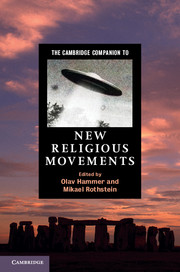Book contents
- Frontmatter
- Introduction to new religious movements
- Part I Social science perspectives
- 1 The sociology of new religious movements
- 2 New religious movements and the evolving Internet
- 3 Major controversies involving new religious movements
- Part II Themes
- Part III New religious movements
- Index
- Other titles in the series
2 - New religious movements and the evolving Internet
from Part I - Social science perspectives
Published online by Cambridge University Press: 28 September 2012
- Frontmatter
- Introduction to new religious movements
- Part I Social science perspectives
- 1 The sociology of new religious movements
- 2 New religious movements and the evolving Internet
- 3 Major controversies involving new religious movements
- Part II Themes
- Part III New religious movements
- Index
- Other titles in the series
Summary
Beijing is used to days like this. April 25, 1999. Mild temperature, medium humidity, and almost no wind combined with the ever-present smog to lower visibility in one of the world's most populous and polluted cities. Patchy drizzle washed over the Zhongnanhai, the leadership complex of the Chinese government, glistening on the pavement and darkening the brick-red background of the large slogan mounted next to the south entrance: “Long live the indomitable thought of Mao Zedong.” Government functionaries passed through the gates, while tourists, student groups, the generally curious, and, as always, the police strolled the square. Another grey day outside China's new “forbidden city.”
Less familiar, however, were the large groups of people gathered along the streets of the Zhongnanhai, standing silently, politely, and, as it seemed, immovably. By the end of the day, around 10,000 Falun Gong practitioners stood there in mute protest against the government that had included them in a sweeping campaign against popular superstition and unauthorized spirituality in the People's Republic of China (PRC). The New York Times described the 1999 Zhongnanhai protest as “the biggest illegal rally in Beijing since the 1989 Tiananmen democracy movement,” something all the more impressive because the group seemed to manage it without alerting the authorities.
A form of self-cultivation rooted in qigong traditions, Falun Gong (also known as Falun Dafa) began in 1992 and grew rapidly, finding fertile ground among the millions who joined by late April 1999. Within a few months of their protest, though, the group was officially banned in China, and since then the Zhongnanhai has mounted a relentless campaign of propaganda and repression against it. Indeed, at a 2007 conference on new religions held in Shenzhen, just across the PRC border from Hong Kong, many Chinese academics (and others) uncritically repeated government claims that Falun Gong is xiejao, an “evil cult.”
- Type
- Chapter
- Information
- The Cambridge Companion to New Religious Movements , pp. 29 - 43Publisher: Cambridge University PressPrint publication year: 2012
- 1
- Cited by

